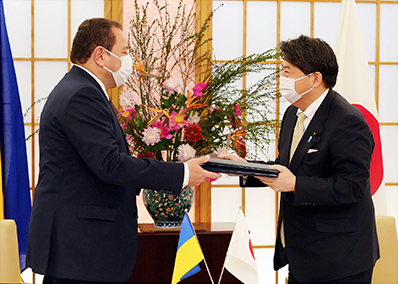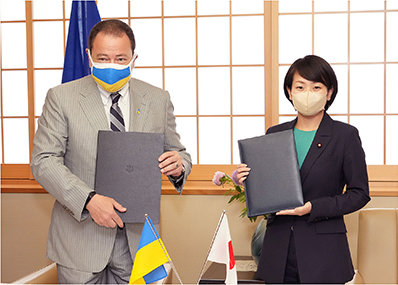(2) Support for the Stability and Reconstruction of Ukraine
A. Japan’s Cooperation to Ukraine to Date
Japan established diplomatic relations with Ukraine in 1992 and started economic cooperation in 1997. Since then, Japan has continuously provided support for the consolidation of democracy, social stability, and transition to a market economy, in order to help Ukraine’s self-reliant and sustainable growth.
In 2005, Japan implemented the “Boryspil State International Airport Development Project” in Kyiv as Japan’s first yen loan project in Ukraine, to support the development of the country’s critical infrastructure. Through this project, Japan contributed to improving the airport’s passenger throughput capacity and users’ convenience by constructing a new international passenger terminal building and related facilities.
When Ukraine fell into political instability after its independence, Japan contributed to the betterment of people’s livelihoods and the regional reconstruction through a dispatch of Japanese electoral observers and a project titled “Early Recovery of Social Services and Peacebuilding in Donetsk and Luhansk Oblasts,” a grant aid for conflict prevention and peace building. In addition, Japan supported financial stabilization through the provision of a “Development Policy Loan.”
Japan so far provided technical cooperation in the areas of macroeconomics, energy, and private sector development, with the aim of building capacity of the people of Ukraine to handle challenges in these areas. The assistance included technical cooperation through the Japan EBRD Fund, JICA training programs, and dispatch of a financial expert as advisor to the Minister of Finance of Ukraine. Japan also provided assistance that would directly benefit people on the ground through Grant Assistance for Grass-Roots Human Security Projects, focusing on health, sanitation, and education sectors. In 2020, during the spread of COVID-19, Japan provided grant aid of up to 200 million yen for the provision of health and medical equipment such as MRI systems (see “Project Introduction Column” for Japan’s assistance in public broadcasting).
Based on this long-standing friendly relation between the two countries, the Government of Japan began providing assistance that would contribute to the stability and future of Ukraine, along with the emergency and humanitarian assistance from the onset of Russia’s aggression against Ukraine.
B. Support for Ukraine’s Stability, Future Recovery and Reconstruction

Dr. Korsunsky, Ambassador of Ukraine to Japan, and Foreign Minister Hayashi exchanging notes concerning the Emergency Economic Reconstruction Development Policy Loan (April 2022)

Dr. Korsunsky, Ambassador of Ukraine to Japan, and then State Minister for Foreign Affairs Suzuki exchanging notes concerning additional loan aid for the Emergency Economic Reconstruction Development Policy Loan (June 2022)
At the G7 Summit held in March in Brussels, Belgium, Prime Minister Kishida expressed Japan’s intention to swiftly provide a loan of 100 million US dollars as a parallel financing with the World Bank to support the Ukrainian economy in addition to emergency and humanitarian assistance. Furthermore, at the Summit-Level Video Conference on the Situation in Ukraine held in April, Prime Minister Kishida announced an increase in financial support from 100 million US dollars to 300 million US dollars, and on May 20, he announced to further double the amount up to 600 million US dollars in total.
The Government of Japan coordinated to fulfill the procedures expeditiously in order to respond to the urgent and short-term financial needs for Ukraine’s economic crisis. As a result, as early as April 28 in Tokyo, Foreign Minister Hayashi and Dr. Korsunsky, Ambassador of Ukraine to Japan, exchanged notes concerning the loan aid “Emergency Economic Reconstruction Development Policy Loan,” in relation to the initially announced 100 million US dollars (13 billion yen) in financial support. On June 7, then State Minister for Foreign Affairs Suzuki and Ambassador Korsunsky exchanged notes regarding additional loan aid of 500 million US dollars (65 billion yen).
In addition to the loan aid, Japan provided assistance of 3 million US dollars Note 5 through the Food and Agriculture Organization of the United Nations (FAO) in April during Ukraine’s planting season to help restore agricultural production by assisting the planting in agricultural land. In July, Japan additionally provided 17 million US dollars Note 6 through FAO to expand its supplemental grain storage capacity for the upcoming harvest season starting in autumn, and to support grain exports from Ukraine by building the technical capacity of its inspection facility, which became necessary as the alternative transportation routes for grain export were operationalized.
Besides the above-mentioned cooperation, Japan provided assistance of 4.5 million US dollars Note 7 in April for emergency debris removal, and mine action through the United Nations Development Programme (UNDP) in order to ensure the safety of civilians in affected communities in Ukraine, as well as to secure access for the delivery of necessary relief supplies. In addition, through JICA, Japan holds seminars online to share knowledge and experience in post-disaster waste management, such as sorting methods and recycling technologies from its experience following the 2011 Great East Japan Earthquake.
In the area of countermeasures against landmines and UXO, Japan supports mine clearance activities in Ukraine in cooperation with Cambodia, where Japan has provided assistance for landmine removal over the years.
- Note 5: As part of the 100 million US dollar additional emergency humanitarian assistance announced in April.
- Note 6: As part of the 200 million US dollar food security assistance announced in July.
- Note 7: As part of the 100 million US dollar additional emergency humanitarian assistance announced in April.
